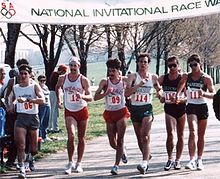
Back Resiesstap Afrikaans Marcha atletica AN سباق المشي Arabic Спартыўная хадзьба Byelorussian Спортно ходене Bulgarian Kerzhadeg (atleterezh) Breton Marxa atlètica Catalan Sportovní chůze Czech Спортла утасси CV Kapgang (atletik) Danish
 Race walkers at the U.S. World Cup Trials in 1987 | |
| Presence | |
|---|---|
| Country or region | World |
| Olympic | Yes |
Race walking, or racewalking, is a long-distance discipline within the sport of athletics. Although a foot race, it is different from running in that one foot must appear to be in contact with the ground at all times. Race judges carefully assess that this is maintained throughout the race. Typically held on either roads or running tracks, common distances range from 3,000 metres (1.9 mi) up to 100 kilometres (62.1 mi).
The current race walking contests at the Summer Olympics are the 20 kilometres race walk (men and women) and the marathon race walk mixed relay, the latter of which debuted at the 2024 Summer Olympics. The 50 kilometres race walk (men only) was discontinued after the 2020 Summer Olympics.[1] The biennial World Athletics Championships also features both 20 and 50 kilometer events, the 50 km walk for women being contested until 2019. The 50 km race walk was replaced by the 35 kilometres race walk as standard championship discipline in 2022. The IAAF World Race Walking Cup, first held in 1961, is a stand-alone global competition for the discipline and it has 10 kilometres race walks for junior athletes, in addition to the Olympic-standard events. The IAAF World Indoor Championships featured 5000 m and 3000 m race walk variations, but these were discontinued after 1993. Top-level athletics championships and games typically feature 20 km racewalking events.
The sport emerged from a British culture of long-distance competitive walking known as pedestrianism, which began to develop the ruleset that is the basis of the modern discipline around the mid-19th century. Since the mid-20th century onwards, Russian and Chinese athletes have been among the most successful on the global stage, with Europe and parts of Latin America producing most of the remaining top-level walkers. However, it has been particularly affected by doping, with many Russian world and Olympic champions testing positive for banned performance-enhancing drugs.[2][3]
Compared to other forms of foot racing, stride length is reduced; to achieve competitive speeds racewalkers must attain cadence rates comparable to those achieved by running.[4]
- ^ Mulkeen, Jon (May 3, 2018). "PREVIEW: WOMEN'S 50KM RACE WALK – IAAF WORLD RACE WALKING TEAM CHAMPIONSHIPS TAICANG 2018". IAAF Official Website. IAAF. Archived from the original on August 30, 2018.
- ^ Wilder, Charley (June 16, 2015). "Where Racewalking Is King, the Antidoping Officials Are Busy". The New York Times. Retrieved August 20, 2021.
- ^ Tétrault-Farber, Gabrielle (January 24, 2020). "Banned Russian race walking coach still working with athletes, official says". Reuters. Retrieved August 20, 2021.
- ^ Eulich, Whitney (August 3, 2012). "Wait... That's an Olympic Event?". Christian Science Monitor. Archived from the original on March 5, 2016. Retrieved August 25, 2016.
The sport requires the stride-rate of an 800 to 1500-meter runner, and a race walker's endurance is the equivalent of a world-class marathoner, says Mr. Peters. "Only you're going longer."